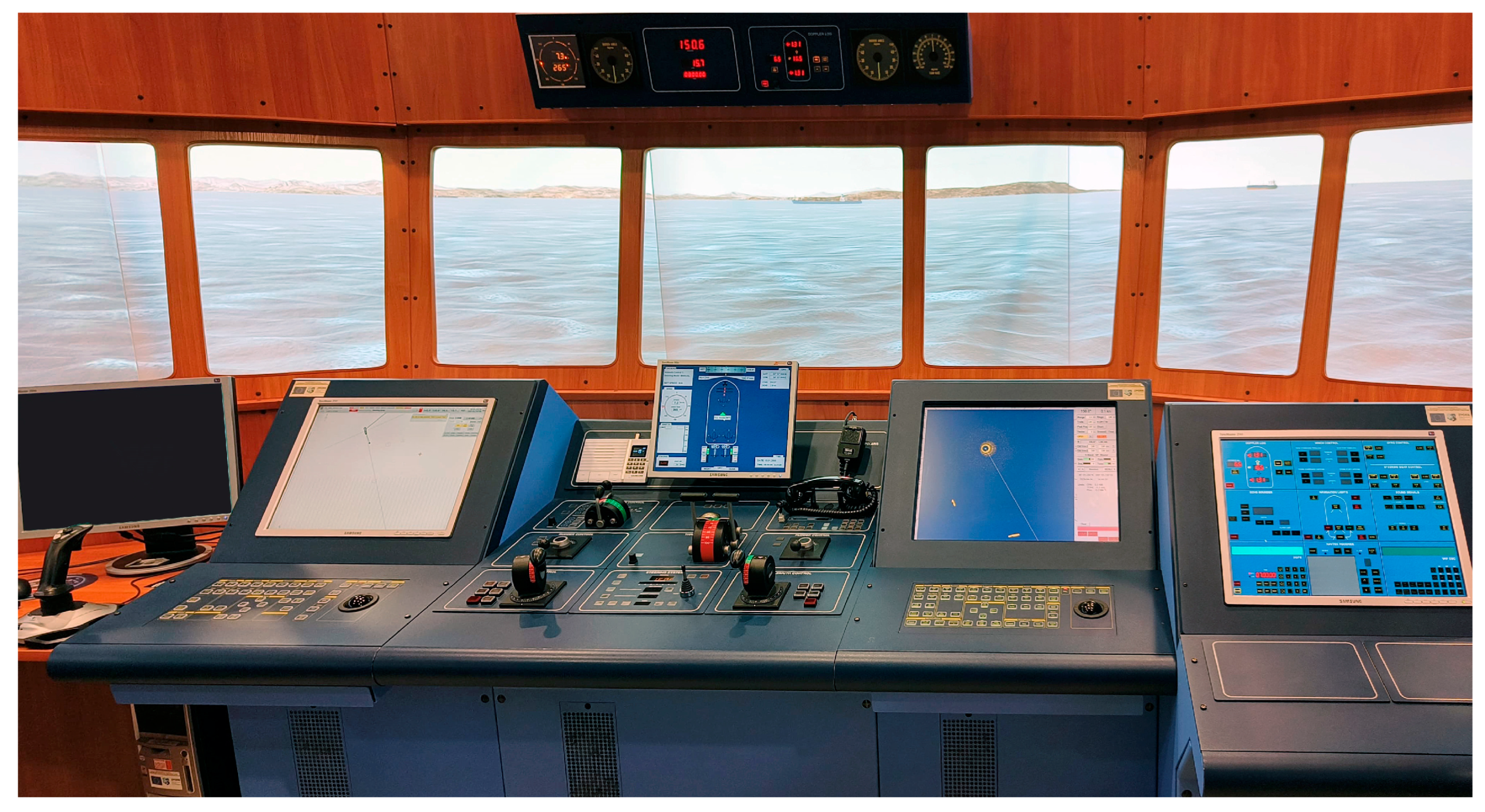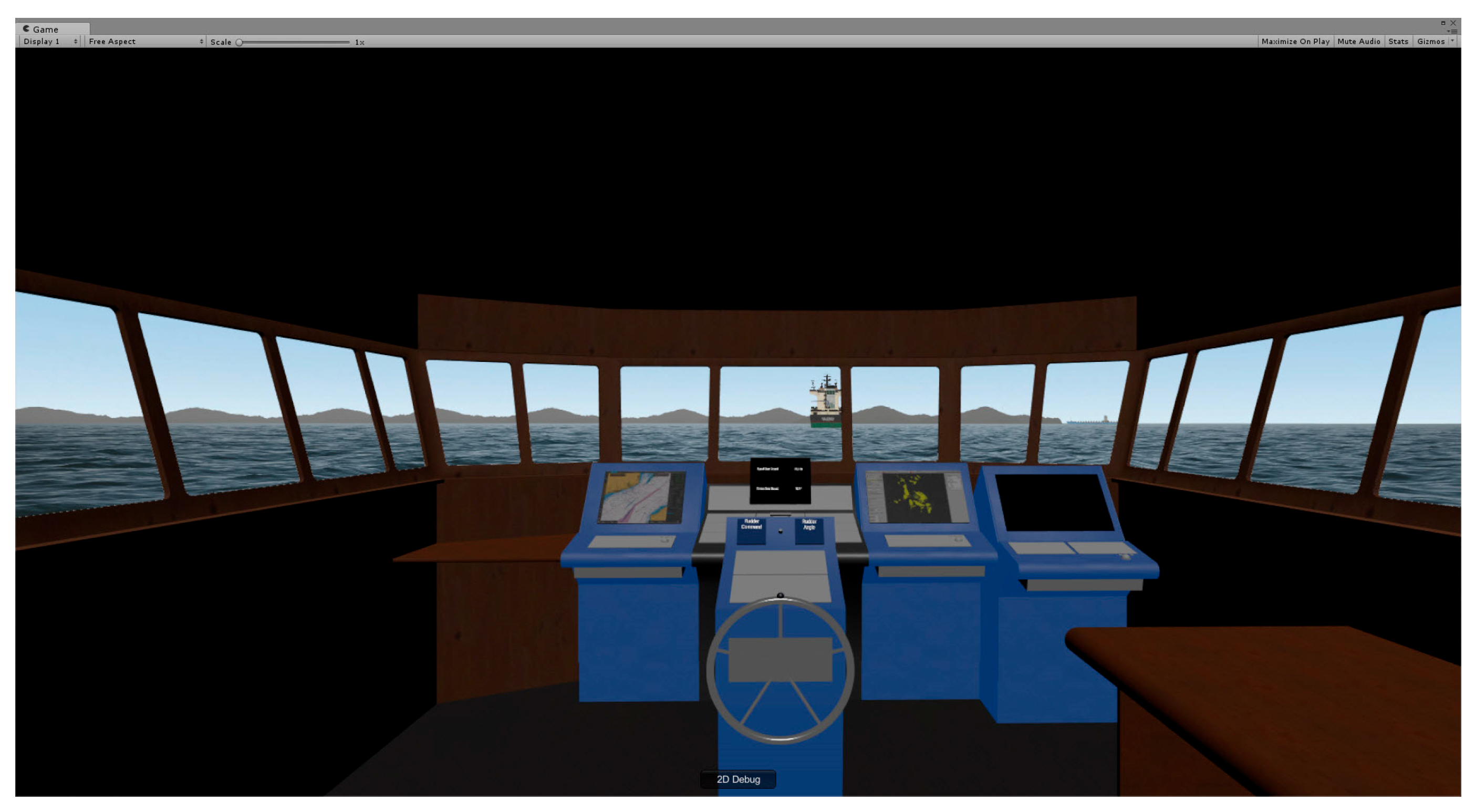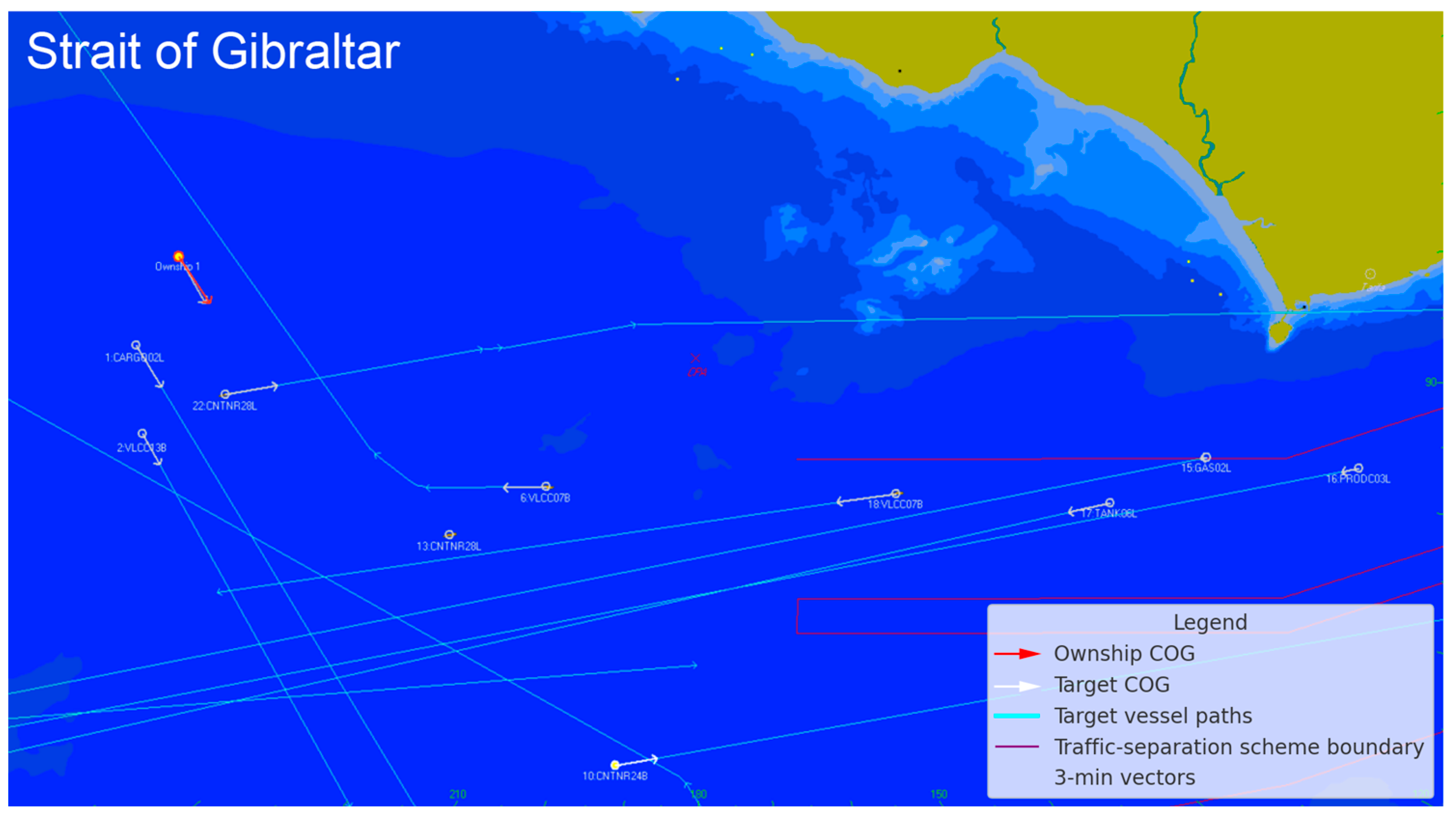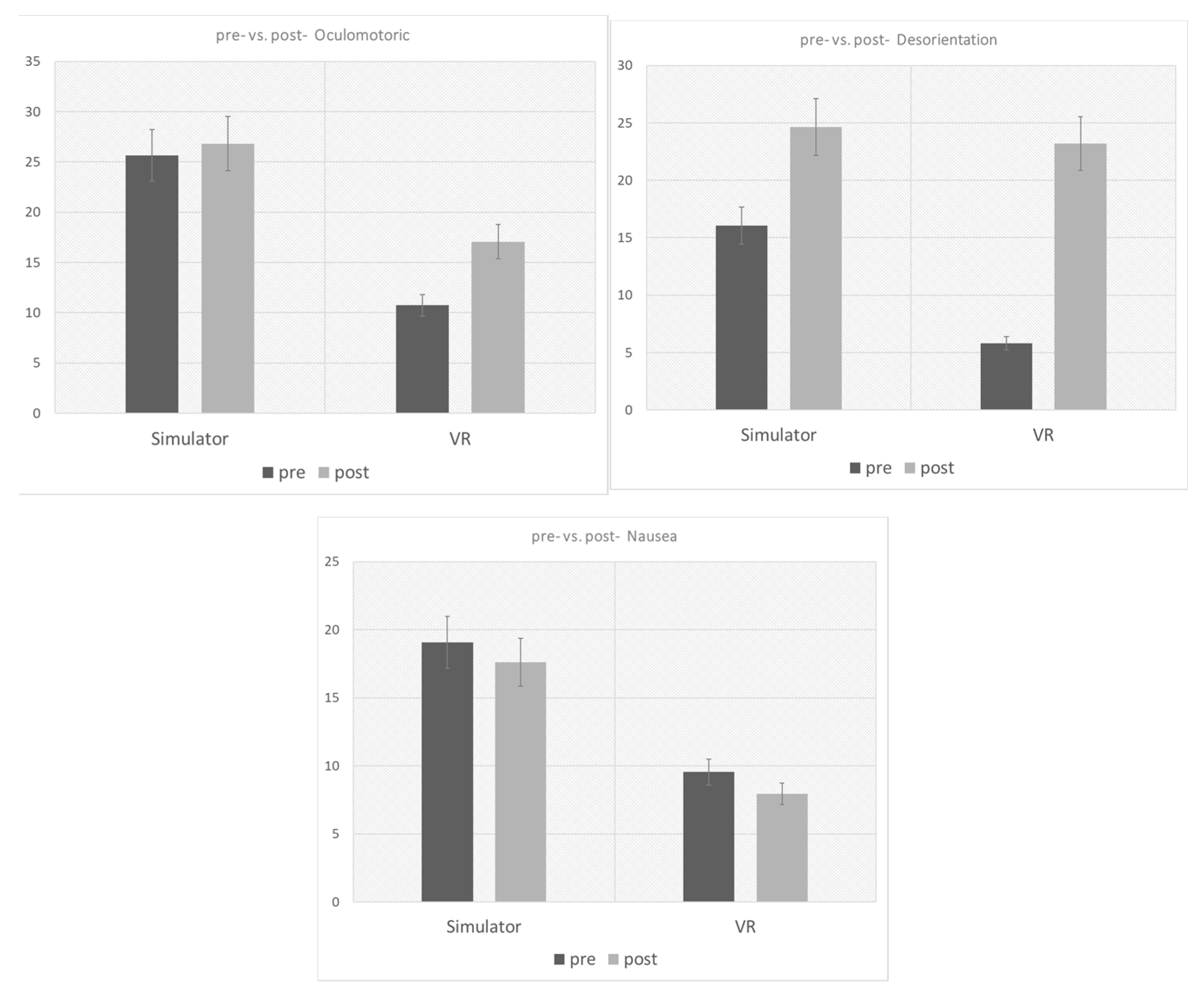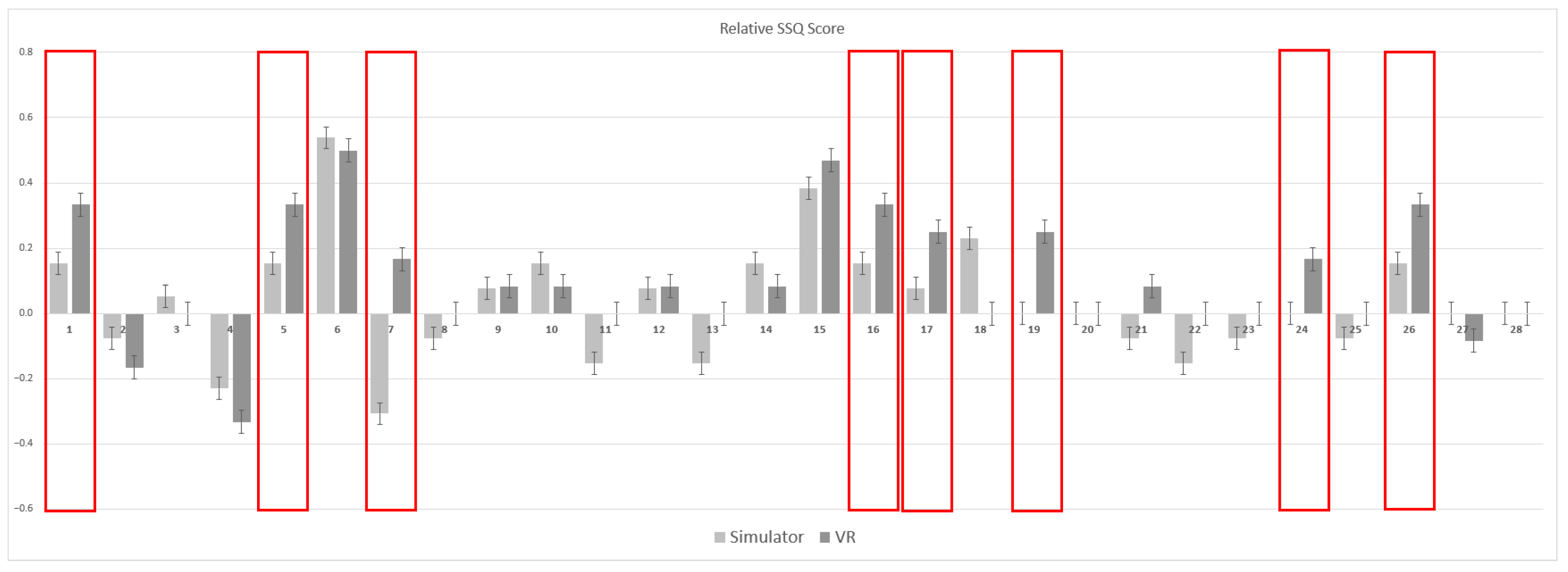1. Introduction
The growing adoption of immersive displays in maritime training, spurred by rigorous STCW competence goals and economic pressures, necessitates a clearer understanding of their physiological impacts. The present study therefore offers a preliminary comparison of simulator-sickness responses among senior cadets observing an identical Gibraltar-watch scenario in two conditions: a certified full-mission bridge simulator (FMBS) and its head-mounted-display (HMD) virtual-reality (VR) counterpart. While VR’s potential in maritime training is increasingly recognized, a critical gap remains in our understanding of its relative impact on trainee well-being compared to established simulators. Specifically, it remains unknown whether the discomfort induced by VR exceeds the accepted baseline levels of conventional simulators when used for standard, calm-weather training scenarios where the trainee acts as an observer. This study addresses this precise gap by providing crucial data for institutions considering the integration of VR into their curricula.
Modern maritime training incorporates a range of advanced learning methods, including e-learning, computer-based training (CBT), simulations, and immersive technologies. Among these, immersive technologies—such as virtual reality (VR) and augmented reality (AR)—have gained significant attention for their ability to transform teaching and learning. Research has shown that these tools enhance student engagement and knowledge retention by offering interactive, realistic environments that simulate complex scenarios otherwise difficult to replicate in traditional classroom [
1,
2,
3]. This shift reflects a broader transformation in maritime education, where immersive technologies are increasingly seen as both a supplement and potential alternative to traditional simulators [
4].
Simulators in particular provide a safe and cost-effective platform for developing navigational skills [
5]. They replicate real-life maritime conditions, enabling trainees to practice decision making and emergency responses with immediate feedback [
6]. The adaptability of simulators to incorporate VR further enhances their realism and training value. For example, VR-based safety training, such as Helicopter Underwater Escape Training (HUET), has been shown to improve skill acquisition, reduce anxiety, and increase overall performance [
7]. Moreover, VR training has demonstrated benefits across diverse populations and has been shown to improve safety training modules such as firefighting, offering cost-effective and time-efficient alternatives to traditional methods [
8], including non-WEIRD groups like seafarers from the Kiribati Islands, by increasing motivation and reducing cognitive load [
9].
Beyond maritime applications, VR has proven effective in various fields, including chemistry education [
10], bridge design [
11], physics instruction [
12], medical training [
13], and even underwater archaeology [
14]. VR has also been applied in astronaut training, where it supports spatial orientation and navigation in simulated space station environments, helping optimize training strategies and improve performance [
15]. In maritime contexts, VR offers high-fidelity simulations of ship bridge operations, providing a scalable and flexible alternative to traditional simulators [
1,
16,
17].
The advent of advanced technologies in maritime training has revolutionized the way seafarers acquire essential skills and competencies [
18,
19]. Among these innovations, conventional full-mission ship bridge simulators and cutting-edge VR systems have emerged as pivotal tools in enhancing the training experience [
20,
21,
22,
23]. However, the integration of these technologies raises significant concerns regarding simulator sickness—a condition characterized by symptoms such as dizziness, nausea, and disorientation, which can adversely affect trainees’ performance and learning outcomes. Research shows that the severity of these symptoms often increases with the duration of VR exposure and may also be influenced by individual factors, such as personality traits, gaming experience, and gender [
24], although some users may adapt over time, while others experience lingering effects even after the session ends [
25]. Recent EEG-based studies confirm that recovery from simulator sickness can take over 11 min, especially in susceptible individuals, and it is accompanied by measurable changes in brainwave activity [
26]. These temporal dynamics are crucial when designing VR-based training programs, especially in high-stakes environments like maritime operations.
Few studies have directly compared FMBS and VR under identical bridge-watch conditions; therefore, it remains unclear whether VR-induced discomfort exceeds the accepted baseline levels of conventional simulators [
27,
28]. It remains unclear whether VR can effectively replace traditional simulators, whether it addresses their limitations, or whether it introduces new issues that could hinder its adoption. For instance, while VR may offer greater flexibility and immersion, it may also lack the physical realism and spatial awareness provided by full-mission simulators. Conversely, conventional simulators, though well established, may be limited in scalability and cost efficiency.
This study addresses that gap by comparing a conventional full-mission bridge simulator and an immersive VR bridge simulator under the same standard navigational watch scenario and benign environmental conditions. We specifically examine whether the VR system induces any greater simulator sickness than the conventional simulator when both are used for an identical training task in calm seas with the trainee in an observer role. Our primary hypothesis, formulated as a null hypothesis, was that under these controlled conditions (calm sea state, clear weather, and passive observation), the VR simulator would not induce a statistically significant increase in simulator sickness symptoms compared to the baseline established by the traditional simulator.
Students underwent a comprehensive assessment aimed at evaluating the intensity and seriousness of the symptoms associated with simulator sickness, utilizing Simulator Sickness Questionnaire (SSQ) to gather detailed information regarding their experiences. Recent studies have shown that SSQ scores correlate with physiological indicators such as heart-rate variability (HRV), particularly RMSSD and LF/HF ratios, suggesting that SSQ may reflect not only subjective discomfort but also measurable autonomic responses to VR exposure [
29]. These findings support the validity of SSQ as a diagnostic tool in immersive training environments. The results of this assessment will be analyzed to identify patterns and correlations, ultimately providing insight into how different training modalities impact trainee well-being and effectiveness.
The verification process aims to compare the characteristics and user experience of a VR simulator relative to a conventional, real-life simulator, exploring its potential role in maritime training and, most importantly, testing whether standard STCW training scenarios, under simulated calm sea and minimal wave-induced motion, implemented in VR simulator generate higher or comparable levels of simulator sickness compared to conventional simulators.
3. Results
3.1. Simulator Sickness Questionnaire Results
The analysis of results included the calculation of the overall SSQ score as well as the three subscale scores: Nausea, Oculomotor, and Disorientation. For every pre- vs. post-exposure comparison, we additionally computed the effect size (Cohen’s r = Z/√N) to quantify the magnitude of the observed differences. The results are presented in
Figure 5 and
Figure 6.
In the case of the conventional simulator, no statistically significant increase in simulator sickness symptoms was observed following the 30 min session. However, the same scenario conducted in VR conditions revealed a statistically significant increase in the overall SSQ score (significance lost after applying the Holm–Bonferroni correction).
Analysis of the SSQ subscales (Nausea, Oculomotor, Disorientation) revealed that Nausea symptoms did not increase significantly in either condition. Disorientation symptoms showed an increase in the VR condition (raw p = 0.021), whereas the conventional simulator showed no significant change in Disorientation. The increase in Disorientation was notably larger in VR than in the conventional session (consistent with participants’ reports of feeling more “swaying” in VR). Oculomotor symptoms increased significantly in VR (raw p = 0.015) but not in the conventional simulator. However, after applying the Holm–Bonferroni correction for multiple comparisons, none of the subscale changes in VR remained statistically significant. In summary, no reliable increases were found in any subscale for either simulator once corrections were made, although the VR condition did exhibit a trend toward higher Oculomotor and Disorientation scores.
We also examined how the individual symptom indicators changed before and after the sessions, separately for the conventional and VR simulators, to identify the most prominent symptoms. The results are presented in
Figure 7. The greatest increases were observed for the following factors:
1—General discomfort,
5—Headache,
7—Difficulty concentrating,
16—Feeling of swaying with eyes open,
17—Feeling of swaying with eyes closed,
19—Visual disturbances,
24—Increased salivation,
26—Disorientation.
The Wilcoxon signed-rank test results showed that in the full-mission bridge simulator condition, the increase in simulator sickness intensity was not statistically significant, neither in the Total nor in the Nausea, Oculomotor, and Disorientation categories. Consistently, all corresponding effect sizes were small (Cohen’s r ≤ 0.27). The test results together with descriptive statistics for each category are presented in
Table 1.
In the VR condition, there were significant pre–post increases in Total SSQ and in the Oculomotor and Disorientation subscales (all
p < 0.03, with medium effect sizes
r ≈ 0.42–0.46), while Nausea showed no significant change. However, after applying the Holm–Bonferroni correction for the four comparisons, none of these VR increases remained statistically significant. In other words, the VR session did induce more discomfort symptoms than baseline by nominal statistics, but those differences did not meet a corrected significance threshold. Complete descriptive and test statistics are presented in
Table 2.
3.2. Qualitative Interview Results
Between two and seven days after the VR simulator session, each participant was individually interviewed. The findings are presented below according to a descriptive thematic analysis, where key themes were identified from the interviews, and their frequencies were quantified. The interviews focused on general impressions of the VR system, evaluations of graphical quality, perceived strengths and weaknesses of each simulator, and participants’ personal preferences regarding simulator-based training.
As the study involved participants with no prior experience with VR technology, a significant proportion (n = 29) expressed overall amazement at the technology and its capabilities, recognizing its substantial potential in education, particularly in the context of training simulators.
A substantial portion of the responses highlighted the superior graphical quality of the VR simulator (n = 29), as well as the sense of full immersion in the simulated environment (n = 28). Participants emphasized that, unlike the conventional simulator, which retains visible physical boundaries, such as ceiling structures, hallways, or other simulation stations, the VR environment created a much more convincing illusion of presence. As one participant noted, “In the conventional simulator, you’re constantly aware that it’s just a mock-up—you see the ceiling above you, the hallway behind you, and other stations around. In VR, wherever you look, you’re still on the bridge and still on the ship” (p6). Another added, “After a while, I started behaving as if the environment around me were real—I was actually trying to avoid bumping into the steering column” (p21).
At the same time, the technical limitations of current VR displays were frequently noted (n = 16), particularly the relatively low resolution and pixel density of the headsets, resulting in the so-called screen-door effect. As one participant described it, “I constantly felt like I was looking through a fine mesh. At first, it was really annoying” (p2). A considerable number of participants also expressed dissatisfaction with the visual resolution in VR (n = 11). As one participant noted, “The graphics looked much better than on the conventional simulator, but the low resolution in VR bothered me. On the projectors, it’s not as noticeable” (p7).
In terms of physical comfort, negative opinions were predominant. Many participants reported increasing discomfort over time (n = 26), especially due to the weight of the headset (n = 21). As one participant remarked, “The experience would be much more pleasant if the headset were lighter or if its weight were more evenly distributed across the head” (p7). Additional negative feedback included issues related to facial perspiration (n = 17) and lens fogging (n = 12), both of which negatively affected comfort and immersion. Interestingly, only two participants spontaneously mentioned simulator sickness symptoms during the interviews, referring to mild dizziness and headache (n = 3).
At the end of each interview, participants were asked whether, given the choice, they would prefer to conduct future training sessions using the conventional simulator or the VR system. The majority expressed a preference for the conventional simulator, citing greater comfort and a reluctance to engage in longer VR sessions (n = 25). As one participant noted, “VR is much more visually impressive, and it really makes an impact—it’s truly remarkable technology—but doing exercises and learning in that format would be too exhausting for me” (p20). Another added, “VR would be a nice change of pace from time to time, but even 30 min felt like a lot. I wouldn’t want to sit with that on my face for an hour” (p7).
Some participants also highlighted the importance of teamwork in conventional simulator sessions (n = 8), where students typically work in teams of 3–5, sharing roles and responsibilities while performing exercises collaboratively. As one student observed, “What makes the sessions on the conventional simulator more enjoyable is that other students are present, and we work together—just like on a real ship” (p11). Another commented, “What I missed in VR was the presence of other students. It felt very lonely in that environment, and it was quite unnatural” (p14).
4. Discussion
This preliminary study compared simulator sickness outcomes in 32 senior cadets using a conventional full-mission bridge simulator versus an immersive VR bridge simulator under identical, optimal conditions. Both sessions took place in calm daylight conditions (Strait of Gibraltar scenario, sea state 1) and followed the same navigational watch task. The participants were fourth-year maritime students (no prior VR experience) and served as observers (not handling controls) to keep conditions consistent and avoid extra strain from VR interactions. With this tightly controlled design, we aimed to isolate differences in sickness between the two simulator types. The findings suggest that under these conditions, the VR system did not provoke significantly more simulator sickness than the conventional simulator. Overall SSQ scores did rise after the VR session (median SSQ Total from 10.6 before to 22.8 after), but this increase was not statistically reliable once a Holm–Bonferroni correction was applied, and the conventional session showed no change. In fact, the average post-session discomfort levels in VR remained in the “moderate” range and were comparable to those seen with the conventional simulator. These results indicate that, at least for a 30 min exercise in calm seas, an HMD-based VR bridge simulator can deliver an immersive experience without a major increase in simulator sickness symptoms relative to a traditional simulator.
Overall SSQ scores showed a modest increase after the VR session (uncorrected
p = 0.018), but importantly, this did not remain significant after the Holm–Bonferroni correction. In contrast, scores after the conventional session were essentially unchanged. Thus, in our study, the VR condition did not produce a statistically reliable elevation in sickness symptoms. Nevertheless, the trend of higher post-VR SSQ scores is consistent with reports from other domains, where immersive VR displays tend to provoke slightly stronger sickness responses than conventional simulators [
34]. Numerous studies of virtual environments document simulator/cyber sickness occurrences (e.g., [
35]); therefore, our findings align with this general pattern, even though our VR effects were small. This suggests that while VR can induce sickness, under controlled conditions, its impact can be kept to a minimum. It is also recognized that factors which can heighten presence in VR, such as wide-field stereoscopy or high contrast, may also contribute to visuo-vestibular conflict, highlighting the need to weigh the pedagogical gains of VR against potential sensory costs [
1].
An unexpected pattern emerged in the pre-exposure SSQ data: baseline symptoms were markedly lower before the VR trial than before the conventional simulator trial, even though both sessions took place under identical physical and temporal conditions. A definitive explanation lies outside the scope of the present study; yet, several clues point to a novelty-driven psychological effect. Participants described the forthcoming VR experience as “intense”, “new”, and “surprisingly real”, suggesting that first-time anticipation may have heightened excitement or mild apprehension, thereby diverting attention from subtle bodily sensations and suppressing their self-report. The role of physiological responses in cybersickness is an area of ongoing research, with studies exploring EEG correlates of VR sickness and recovery patterns (e.g., ref. [
26]). Similarly, [
36] underscored the importance of emotion regulation and psychological priming in VR exposure therapy. Together, these studies imply that elevated arousal associated with novelty can recalibrate symptom awareness in VR users.
Additional factors may have magnified the effect. The fixed protocol exposed students first to the familiar bridge simulator and only then to the new VR laboratory. Familiarity with the conventional setup—and its minor discomforts—contrasted sharply with the heightened sense of novelty and visual immersion typically reported during a first VR exposure. It has been discussed that high levels of perceived realism and attentional absorption in immersive VR [
37] might, particularly in early exposures, influence how users attend to and report subtle bodily sensations or baseline discomfort. Ref. [
38] demonstrated that repeated exposure in VR environments induces a measurable habituation response, lowering simulator sickness across sessions. Similarly, studies investigating the user experience in VR, such as those examining the impact of introductory tutorials, have found that lower levels of cybersickness are associated with better scores on factors like presence and immersion [
39], which may suggest a link between perceptual immersion and sensory adaptation processes. Future research should therefore counterbalance session order and include objective arousal measures (e.g., heart-rate variability) to disentangle novelty, expectation, and genuine physiological strain—an essential step before rolling out immersive technology to novice maritime trainees.
Further analysis of the SSQ subscales revealed a clear symptom profile: only Disorientation (raw
p = 0.021) and Oculomotor (raw
p = 0.015) increased after VR, whereas Nausea remained unchanged in either environment. This observed ocular-spatial dominance is consistent with reviews of cybersickness literature, which indicate that Disorientation symptoms are predominant in cybersickness, while Oculomotor symptoms are typical of simulator use in general [
40]. A consistent picture therefore emerges: visuo-vestibular conflict, display latency, and fixed-focus stereoscopy selectively tax oculomotor control and spatial orientation, leaving gastric symptoms comparatively unaffected [
41,
42]. A notable predominance of disorientation symptoms was also observed by [
43] in a study involving a VR flight simulator, where mean disorientation scores were found to be higher than those for nausea and oculomotor discomfort in both virtual and mixed-reality conditions. Stereoscopic depth cues, although indispensable for judging bearing and range, impose a built-in mismatch between vergence (eye convergence) and accommodation (lens focus) whenever the display’s focal plane is fixed. This vergence–accommodation conflict (VAC) forces the oculomotor system to decouple normally linked mechanisms, elevating extra-ocular muscle load and suppressing fusion [
40,
42]. In ship-bridge tasks, the problem is magnified because relative bearing is extracted from sub-2° angular shifts against the horizon. Research investigating stereoscopic displays has shown that such viewing conditions can lead to increased visual discomfort and measurable changes in binocular vision parameters, such as fusion range, particularly in individuals with moderate binocular status [
41]. Furthermore, review studies highlight that the vergence–accommodation conflict inherent in fixed-focus stereoscopic displays can decrease the accuracy of binocular fusion and potentially affect depth judgments in VR environments [
40,
42]. Our headset’s optical architecture therefore likely exacerbated the oculomotor strain captured by the SSQ and could have biased students’ closest-point-of-approach estimates by several cables. Future maritime-VR designs should evaluate dynamic-focus (varifocal) optics or multilayer light-field displays, as these are considered promising approaches for reducing vergence–accommodation conflict and associated visual fatigue [
42], with ongoing developments in varifocal systems designed for this purpose [
40,
44]. Participants also noted a faint screen-door pattern—a pixel-grid artefact commonly reported when pixel density falls below approximately 20 PPD. The screen-door effect is known to reduce visual clarity and can contribute to visual discomfort or oculomotor strain [
45], while other display performance issues, such as motion blur, can also impair visual acuity and overall visual clarity [
46]. Both artefacts are consistent with the optical and temporal limits of the headset used in this study: an HTC Vive Pro Eye (90 Hz, ≈ 615 ppi, 110° FoV). Because VAC distorts the perceived depth of distant objects [
42], and the screen-door effect degrades fine visual detail [
45], both phenomena could impair a watchkeeper’s judgement of relative distance and closing speed—critical cues for early collision-avoidance decisions at sea.
Applying the step-down Holm–Bonferroni procedure to the four Wilcoxon signed-rank tests (Total, Nausea, Oculomotor, Disorientation) showed that none of the raw
p-values survives family-wise correction. The smallest raw value, 0.015 for Oculomotor, exceeds the first Holm threshold (α/4 = 0.0125), stopping the sequence and rendering all comparisons non-significant. For completeness, the adjusted
p-values are 0.060 (Oculo-motor), 0.060 (Total), 0.060 (Disorientation), and 0.359 (Nausea). The corresponding Wilcoxon statistics were as follows: Total Z = −2.40, Oculomotor Z = −2.57, Disorientation Z = −2.39, and Nausea Z = −0.98 (N = 32). Thus, while the descriptive rank order remains Oculomotor > Disorientation ≫ Nausea, the family-wise test indicates no statistically reliable differences. The median post-VR SSQ Total was 27 (IQR 14–38), with a mean of 22.75 ± 17.79; both indices place the cohort in the moderate-severity band of the original SSQ classification (0–10 none, 10–30 moderate, >30 severe; Kennedy et al., 1993 [
47]). Thus, while the average discomfort level remained mid-range, the large inter-individual spread (SD = 17.79) means some students approached the severe range; therefore, any inference about meaningful change must be made with caution.
While our study did not directly measure task performance, it is important to consider the potential operational implications of increased SSQ scores based on the wider literature. Operationally, even a moderate rise in SSQ can translate into measurable performance deficits, as reviews suggest that cybersickness symptoms can negatively impact attention, concentration, and reaction times, potentially reducing students’ performance in VR tasks [
40,
48]. We adopt this order-of-magnitude estimate for bridge watchkeeping, recognizing the task and environment differences. The potential for such performance decrements resulting from increased SSQ scores warrants careful consideration, especially in the context of time-sensitive maritime operational tasks. Disorientation reinforces the risk. For instance, ref. [
49] found that higher scores on the Disorientation subscale of the SSQ were a significant predictor of poorer spatial ability in a VR task, indicating increased error in spatial judgments. Given that disorientation can impair spatial judgments, significant increases in this symptom, such as those observed in our study, could plausibly affect critical maritime tasks like estimating the closest point of approach, thereby increasing operational risk. To curb these risks, we endorse striving for low motion-to-photon latency, as values around or below 20 ms are generally considered important for comfort (cf. [
40]), and we further recommend limiting initial HMD sessions by adopting strategies such as initially shorter exposure times with adequate rest periods (consistent with the general advice reviewed in Souchet et al., 2023) and considering established discomfort thresholds for aborting sessions (e.g., an SSQ Total score exceeding 40, as discussed by [
48]). Further research may be needed to establish specific, validated thresholds for objective measures like ocular-vergence variance. Optimizing the hardware by considering factors such as higher refresh rates (e.g., 75–95 Hz or more, as noted by [
40] for reducing cybersickness), adequate pixel density (with current devices offering around 20–22 PPD, e.g., ref. [
46]), and appropriate field-of-view optics is important for minimizing potential visual stressors like vergence–accommodation conflict and screen-door artefacts. Stepwise exposure and objective sickness monitoring thus become integral elements of a safe, competency-based VR curriculum for students.
Several limitations temper these conclusions. Cognitive load was not quantified; yet, psychophysiological evidence from maritime VR simulations shows that high mental workload can amplify fatigue and reduce navigational accuracy. EEG-based monitoring revealed that elevated cognitive demand was associated with poorer task performance and increased likelihood of failure in immersive bridge scenarios [
50]. The study also omitted a validated presence scale, such as the ITC-SOPI or the Igroup Presence Questionnaire, leaving the moderating role of subjective immersion unexplored. A fixed exposure order, with the conventional session always preceding VR, may have inflated novelty effects, and the observer-only role limits generalization to hands-on helm operations. However, this sequence was also chosen for its ecological validity, as it mirrors the likely real-world scenario where VR is introduced as a supplement to existing, familiar simulator training. Future research should therefore counterbalance session order, combine the SSQ with presence and workload measures, and integrate biometric sensors plus eye-tracking to map psychophysiological load during fully interactive bridge tasks.
Translating these findings into practice, we recommend three mutually reinforcing measures for the safe rollout of VR in maritime curricula. First, optimize the hardware: select headsets aiming for robust ergonomic characteristics, such as high refresh rates (e.g., 75–95 Hz or more, noted by [
40] as beneficial), adequate pixel densities (with current devices often featuring around 20–22 PPD, as contextualized by [
46]), and low motion-to-photon latency (striving for levels well below 20 ms, cf. [
40]). These specifications target the main visual stressors identified in this study, such as vergence–accommodation conflict, which contributes to oculomotor strain and spatial misjudgment (e.g., ref. [
42]), and screen-door artefacts, which degrade image clarity and can contribute to visual fatigue (e.g., refs. [
45,
51]).
Second, codify a safety protocol and prepare instructors. Students should complete a brief medical and motion-sickness screen, receive a supervised orientation session, and follow explicit abort criteria—such as terminating exposure when SSQ Total exceeds 40, a threshold commonly associated with high discomfort levels in immersive VR scenarios [
40]. Managing exposure duration, for example by starting with shorter sessions (e.g., in the range of 10–30 min, as suggested by some authors reviewed in [
48]) interspersed with adequate rest periods, and gradually extending duration based on user comfort (e.g., ensuring discomfort remains within a non-severe range, such as below an SSQ Total of 30–40 points) is advisable. Instructors need dedicated preparation, covering both pedagogical sequencing and real-time symptom management. Continuous monitoring—via eye-tracking, heart-rate variability, and a five-point discomfort scale—may be valuable for detecting emerging problems before learning quality deteriorates. Similar onboarding routines and safety protocols were introduced during the national rollout of immersive pilotage training in Norway, where preliminary evidence suggests successful integration into professional curricula despite technical and instructional challenges [
52].
Gradual acclimatization remains the most practical countermeasure for novice students. Short, largely static watch modules should precede dynamic maneuvering tasks, so that physiological adaptation can occur without overwhelming sensory conflict. Furthermore, it is generally understood that for effective learning in VR, cybersickness levels should be minimized, as high discomfort can impede immersion and knowledge transfer. This aligns with theoretical frameworks, such as the Cognitive Affective Model of Immersive Learning (CAMIL), which posits that factors like cybersickness can create extraneous load, thereby reducing the learning benefits of VR (as discussed in [
9]). The importance of managing user state is underscored by evidence linking lower cybersickness levels (often assessed via self-report) to better learning outcomes and by psychophysiological research using EEG that has correlated user states with performance in VR training scenarios, where cybersickness was also a measured factor [
50]. Our own data reinforce the need to pace exposure accordingly. Alongside stepwise exposure, students should be taught to recognize early symptoms and apply self-regulation strategies—briefly closing the eyes, slowing head turns, or requesting a pause—thereby cultivating autonomy in symptom control.
In summary, our findings show that an immersive VR bridge simulator can be integrated into maritime training with minimal simulator sickness, provided the scenarios are carefully controlled. VR can reproduce bridge sightlines, lighting, and traffic complexity with a level of realism unattainable in conventional mock-ups, and in our study, this came without a significant increase in sickness symptoms under calm conditions. That said, the current VR setup did impose some moderate physical discomfort on first-time users (headset weight, visual strain)—a trade-off, which must guide curriculum design. Lesson blocks should remain short and progressively paced until technical parameters, such as motion-to-photon latency (aiming for levels well below 20 ms, cf. [
40]) and pixel density (striving for levels that minimize the screen-door effect, with current devices around 20–22 PPD, cf. [
46]), are further improved to enhance user comfort and performance. It is acknowledged, however, that the hardware meeting these high-end specifications often requires a significant financial investment and may not be readily accessible to all institutions, highlighting a practical trade-off between ideal performance and widespread adoption. Furthermore, it is important to emphasize that these findings are constrained to the specific conditions tested: a passive observer role under benign, calm-sea conditions. Future research is therefore essential to investigate how these outcomes might change under more demanding and operationally realistic scenarios, such as those involving active vessel control, complex maneuvering, and rough sea states. The baseline SSQ values were paradoxically lower before the VR session, reinforcing evidence that novelty-driven arousal can mask incipient symptoms—a pattern that may be linked to psychological factors such as novelty-driven arousal potentially influencing self-report and symptom awareness.
Only objective arousal indices and counterbalanced designs will disentangle this psychological confounder. Future research should therefore evaluate varifocal or light-field optics that resolve the vergence–accommodation conflict, which are considered promising approaches for reducing associated oculomotor strain (cf. [
40,
42,
44]); quantify how cumulative exposure shapes sickness trajectories over multiple voyages in the virtual Strait of Gibraltar; and determine whether higher-resolution, lighter headsets (an area the authors are currently exploring using Varjo XR technology) further reduce oculomotor strain without sacrificing presence.
